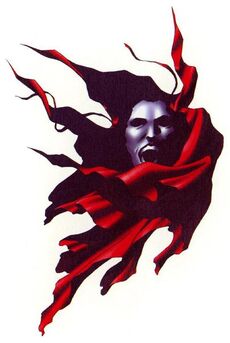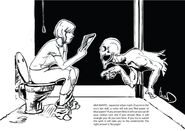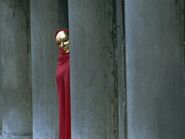| Aka-Manto | ||
 | ||
| Information | ||
|---|---|---|
| Romanized | Aka-Manto | |
| Kanji | 赤マント | |
| Meaning | Red cape | |
| Type | Unknown | |
Aka-Manto (赤マント or あかまんと, Aka-Manto) is a Japanese urban legend about a malicious spirit who haunts public and school toilets, who will ask you if you want red paper or blue paper. In some versions, he will ask you if you want a red or blue cape. Often described as a beautiful man in life and hounded constantly by admirers, he now wears a mask to hide his face.
Description
Aka manto is an urban legend related to toilets—particularly those in elementary schools. This phenomenon is known all over Japan, with countless variations on the same theme. It usually takes place in a specific stall in a specific bathroom in the school. Usually it is an older or seldom used bathroom, often in a stall with an older style squat toilet. Often the fourth stall is the cursed one, as the number four is associated with death.
Most stories follow this general pattern: while at school late in the evening, a student suddenly finds him or herself in desperate need of a toilet. The closest restroom available is one that is normally avoided by the students; it is older and less well-kept, separated from the rest of the school, and is rumored to be haunted. But with no time to search for a different restroom, the student enters. He or she does their business, and when they have finished, they reach for the toilet paper only to find that there is none. Then they hear a strange voice: “Do you want red paper? Or blue paper?” The student answers, “Red paper,” and a moment later is stabbed and sliced up so violently that blood sprays everywhere, soaking their body and making it look as if they were wearing a bright red cloak. Some time later, another student finds him or herself in need of a toilet in a similar situation. They know the rumors that a student died in the restroom, but they have no choice and use the bathroom anyway. Sure enough, a voice asks them, “Red paper or blue paper?” Remembering the legend, this student says, “Blue paper.” Then, all of the student’s blood is sucked out of their body, leaving them dead and blue-faced on the floor.
Plenty of variations of this legend exist, each with minor differences. The true identity of Aka manto is one of these. Sometimes it is said to be a person hiding in the adjacent stall—a serial killer in many stories. Other times it is a ghost who appears as a tall man with a sickly, bluish-white face. In some places it is even blamed on a hairy yōkai called a kainade who lives in the toilet and likes to stroke people’s rear ends with its hand. In the kainade’s case, the end result is markedly less violent: a hairy arm of the chosen color rises out of the toilet to stroke the student’s behind.
In some cases, instead of draining your blood, “blue paper” gets you strangled until your face turns blue. Sometimes answering “red paper” gets your skin flayed so that it hangs off of your back like a red cape (a play on the “aka manto” name). In other versions, instead of being killed, the student’s skin color will change permantly to whatever color he or she chose. Sometimes those who survive and tell the story to others fall terribly ill and die shortly after. And sometimes the consequences are worse than death, such as being dragged into the netherworld, never to be seen again.
The questions have many variations as well, including “red vest or blue vest,” “red hand or blue hand,” or “red tongue or blue tongue.” Sometimes the colors are red or white, instead of blue. When the choices are red or white paper, red often results in a red tongue rising up out of the toilet to lick the student’s rear end, while white results in a white hand rising up to stroke the student’s rear end. Less common choices are red paper or purple paper: choosing purple allows the student to escape unharmed, while choosing red causes the student to be pulled down through the toilet into the plumbing.
As with many urban legends, there is usually no escape from your horrible fate—though that doesn’t stop people from trying. Clever students who bring extra toilet paper with them discover that it vanishes before they are able to use it, and still find themselves having to answer to Aka manto. People who choose a different color other than those offered in hopes to confuse the spirit are met with an equally horrible death (one common version has a student say “yellow paper,” and the result is that their face is pushed down into the dirty toilet water and held there until they drown). In some instances, students have been able to escape by saying “I don’t need any paper,” buying them just enough time to run out of the bathroom before anything happens.
Tracing the origin of urban legends can be difficult. Aka manto is fairly old as far as urban legends go. It is recorded as a popular schoolyard rumor as early as the 1930’s, and its popularity hasn’t faded even as newer toilet legends (such as Toire no Hanako-san) have come into existence. One explanation for Aka manto’s origin and continued popularity is in its nature. It may be a reflection of the anxiety inherent in being a student. Aka manto asks children an impossible question to which any answer results in something terrible. That feeling is not too different from having to answer a difficult problem on a test, or a teacher’s question in front of the whole classroom when you don’t know the answer.
Aka manto’s appearance has changed over time along with the Japanese lexicon. Today, manto is the Japanese word for a cloak or a cape, and so aka manto is usually depicted wearing a long red hooded cloak. However, in the 1930’s when this urban legend was born, manto referred to a shorter, sleeveless kimono jacket. As a result, different generations have different visual impressions of what Aka manto looks like.


